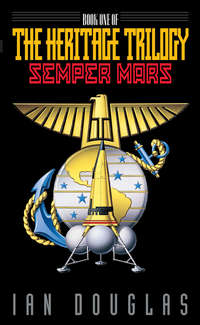
Полная версия
The Complete Heritage Trilogy: Semper Mars, Luna Marine, Europa Strike
“On behalf of a grateful nation and a proud Marine Corps,” Mackley said quietly, “I present this flag to you in recognition of your husband’s years of honorable and faithful service, and his sacrifice for this nation.”
Mackley handed Janet the flag, then saluted her. “Port…harms!” a voice rasped out. “Order…harms! Detail…dis-missed!”
The crowd began breaking up, some of them wandering back toward the shady curve of Halsey Drive, others standing in small groups, talking. Several came up, saluted him, and said…something. He never heard the words. He wanted to say something himself to Janet and Jeff…but when he turned, he saw that Stephanie had led them away, her arm around Janet’s shoulders. He felt…alone. And empty.
Warhurst closed his stinging eyes. You bring a son into the world, raise him, educate him, love him, grieve with him, rejoice with him. You watch him choose your own branch of the service, graduate from Annapolis, go on to his first command, be chosen for the honor of embassy duty. You see him get married, see him begin a family of his own.
And at the end, there was nothing to show for it all but a folded flag.
And the memories.
Warhurst drew a ragged breath. For a moment, he could have hated the tradition, the parade-ground finery, the solemn grandeur and the emotion-wringing symbolism. Ted had died in a fucking incident in a country that Warhurst didn’t give a damn for, an incident, not even a real war. According to the latest netnews downloads, Mexico was charging that American Marines had fired on civilians, precipitating the regrettable attack by Army forces on the American embassy. Pundits, politicians, and bureaucrats would be arguing over the blame for months to come, but nothing had been settled.
What was it all for? What was the use? Damn it, his son was dead….
The Marine Corps. The term “marine,” of course, had its roots in seafaring tradition…a soldier who fought at sea. Since the founding of the Corps in November of 1775, though, the term had become synonymous with a very special elite, a force-in-readiness, a unit ready and able to fight anywhere at short notice.
Everywhere. On distant coral atolls. In disease-festering swamps. Now, possibly, thanks to him, even the surface of another world.
Or the roof of an embattled embassy in Mexico City, in an incident….
He drew another breath…and another, willing the tears to recede. He would not give in to self-pity. There was too much at stake.
Ritual. Tradition. His son had died in the best traditions of the service.
The Marine Corps would continue.
He would continue.
Somehow….
EIGHT
Mars Prime/Cydonia Prime: The two principal human settlements on Mars during the first, exploratory phase of the colonization effort. Mars Prime was established July 20, 2024, at Candor Chasma (5° S, 75° W), near the Martian equator, its location dictated by the interesting local geology and ease of access from orbit. Cydonia Prime was established November 1, 2028, at Cydonia (40.9° N, 9.5° W), in order to study in place the alien artifacts and monuments discovered there.
By 2038, each base complex could support eighty to one hundred personnel. Dedicated structures included subsurface living, recreation, and storage buildings, labs, C3 facilities, wells for tapping permafrost for water, and automated cracking and storage plants for the manufacture of methane fuel from water and atmospheric CO2.
—Download from Networld Encyclopedia
vrtp://earthnet.public.dataccess
SATURDAY, 26 MAY: 0357 HOURS GMT
Pad One
Cydonia Base, Mars
Sol 5634: 1610 hours MMT
“I never thought I’d see the day,” Garroway said, “when a couple of enlisted men would actually volunteer. Especially Slidell.”
Gunnery Sergeant Knox shook his head, the motion just visible inside his helmet. “Man, if I’ve learned anything in twenty years in the Corps, it’s never trust a Marine who volunteers for shit details.”
“Slider isn’t exactly the kind of Marine who volunteers for anything,” Colonel Lloyd said. “I’ve been wondering about that guy. He’s been looking for ways to get to Candor ever since we switched landing sites.”
“So why’ve he and Fulbert been so damned anxious to get down there?” Knox wanted to know. “I heard scuttlebutt that they managed to smuggle some drugs out from Earth.”
“That doesn’t seem likely, does it?” Garroway said. “Not with the weekly medcheck.” Once a week every person on Mars donated a drop of blood and a specimen of urine to the med-lab analyzers. The general medical monitoring of the expedition members’ health was not aimed specifically at spotting drug use, but it would certainly detect it if it happened.
“Ah, who knows what goes through their minds?” Lloyd growled. “I’ve already e-mailed Barnes at Candor to let him know to keep an eye on those two.”
They were standing outside the main hab at Cydonia, watching the preparations for a lobber launch. The two enlisted Marines in question, Corporals Jack Slidell and Ben Fulbert, had just climbed the ladder and boarded the ship, and in a few more minutes they would be on their way to Mars Prime, the big base at Candor Chasma on the Martian equator five thousand kilometers southwest of Cydonia.
It had been two weeks since they’d landed at Cydonia, two busy weeks as the MMEF Marines had worked to get settled in and check out the gear they’d brought with them. Most of their stuff had gone on to Mars Prime at Candor Chasma, and they’d had to manage with a lot of make-do.
The political situation was tense and growing worse. Colonel Bergerac, the new UN force commander, had vigorously protested the unannounced and unscheduled redeployment of the Marines to Cydonia. Only this morning had the last of the 2nd Demibrigade Foreign Legion troops assigned to the UN observers’ force finally shuttled north again to Cydonia Prime, after their redeployment to Candor. It had made things uncomfortably crowded at Cydonia. With nearly thirty Marines, over fifty Foreign Legion troops, and over fifty civilians, the base’s life-support systems were being severely strained.
For that reason, lobber shuttle flights between the main supply dump at Mars Prime down at Candor Chasma and Cydonia Prime had been increased.
Garroway looked up at the lobber resting on the charred strip of regocrete that served as launchpad and landing pad and wreathed in slow-curling clouds of steam. It was Harper’s Bizarre, the dinged and battered-looking shuttle that had aerobraked them in from cycler orbit, but the crews at Candor had replaced her fuel stack and taken her down to her lobber configuration.
For trips to orbit and back, the shuttle rode atop a twenty-meter, double-ring stack of fuel tanks holding the methane reaction mass needed for high delta-v maneuvers, plus the broad, lopsided blister of the heat shield used in aerobraking. Now, however, the blunt-nosed biconic nose section housing cockpit, passenger compartment, and main cargo bay had been remounted on a suborbital boost platform. This was a single ring of smaller methane tanks nestled inside a wirework basket, swaddled in thermal blankets, and resting on four widely splayed legs. In this configuration, the shuttle was called a lobber and was used for point-to-point transport of personnel and cargo on the Martian surface.
“All personnel,” a voice sounded over their helmet headsets. “Lobber Three is now ready for launch. Please clear the launch area.”
“That’s us, gents,” Lloyd said. “Let’s get inside.”
“Roger that,” Garroway said. There was little radiation hazard from the NIMF—the NTR engine was well shielded—but the plasma that seared out of the aft venturi was hot, nearly five thousand degrees, and deadly at close quarters.
“How’re you settling in, Major?” Lloyd asked as they walked back toward the main hab.
Garroway grimaced, his gaze shifting to the bleak, brick red horizon with its oddly shaped mesas and black, pyramid-mountains. “Look at it, sir. The biggest beach in the solar system,” he said. “But no ocean. No palm trees. No nude, sun-worshiper tourists.”
“Hell,” Knox said. “No air.”
“I really do hate this place,” Garroway said. “Sand with no ocean in front of it sucks.”
“Vacuum sucks, sir,” Knox pointed out reasonably as he opened the outer airlock door. “A physical fact.”
“Shit, what’re you two griping about?” Lloyd asked. “There’s no vacuum here.” He waved an armored hand. “Lots of air! You just can’t breathe it!”
Garroway chuckled. He’d said much the same to Kaitlin in his last vidmessage, and he was expecting to be thoroughly roasted for it. She wanted to get into space so badly she could taste it; all he wanted was to get back to Earth…and start looking at Bahamian beachfront property.
He wondered what she was doing now.
0411 HOURS GMT
Site 12
Cydonia Base, Mars
1625 hours MMT
“There she goes,” Dr. Craig Kettering said.
David Alexander turned, looking toward the south. A dazzling flare of light emerged from behind the low, Quonset-hut shapes of the base habs, rising rapidly into the afternoon sky. Seconds passed, and then faint and far off, he heard the high-pitched crackle of the rocket’s launch-thunder.
“About damned time,” he said.
“There’s the jolt,” Dr. Devora Druzhininova said as she watched the main seismic readout panel. “Force two, this time.”
“Just tell me when it’s over,” Alexander said.
Alexander, Kettering, and Druzhininova were standing next to the portable SIT console that they’d set up outside their Mars cat about two miles northwest of the Cydonian base, to the west of the enigmatic structures known as the Ship and the Fortress.
It was a place of titans. The popular press and some of the less responsible of the netnews services had christened the Cydonian Complex the Golden Plain of the Gods, and, at times, Alexander could almost sympathize. The Face, the mile-long Mt. Rushmore of Mars, as one account had called it, was not the only gigantic structure on this stretch of what once, long ago, had been a beach on a short-lived ocean. West lay the so-called City, four pyramids each easily the size of the Great Pyramid at Giza on Earth, centered on a still-buried gridwork of buildings, tunnels, and ruins. Those pyramids, in turn, were dwarfed by an encircling pentagon of much larger structures, natural mountains smoothed into pyramid shapes, each a mile across at the base.
To the east lay the Fortress, a structure believed to be the foundation of another mile-wide pyramid but with the upper two-thirds missing. The Ship, more enigmatic still, appeared to be a mile-long double-spiral tower that, millennia ago, had toppled across the Fortress and now lay half-embedded in the rubble. No one was certain what, exactly, the thing had been; the best guess was that it had been an enormous spacecraft, though either it was of extremely unusual design, or all that was left was a part of the twisted inner skeleton. So far, after sixteen years of digging and poking about the thing, nothing like engines, power plants, or living quarters had been found. It was like trying to guess the shape, color, and purpose of a long-buried automobile when all that you had to examine was a piece of rusted chassis.
That, of course, was what archeology was all about. Xenoarcheology, as it was developing on Mars, at any rate, had the singular advantage of uncovering ruins that had never been scattered, reused, or built upon by succeeding generations of inhabitants. In a way, that advantage was a disadvantage as well; excavations thus far at Cydonia had uncovered artifacts enough to fill storehouse after storehouse, far more than could possibly be shipped back to Earth, but scientists so far had been able to identify—guess at, actually, was the better phrase—perhaps one percent of everything catalogued so far.
And the real excavations hadn’t even begun, yet. Since the first visit by humans to the site in 2024, archeological teams numbering from four to twelve had managed only to survey perhaps two percent of the entire complex. It was, Alexander thought, a task similar to sending a dozen people into Manhattan with instructions to visit, map, catalogue, photograph, and explore every street, building, alley, vehicle, ship, aircraft, and park on the entire island. The survey alone could take a century or more…and only then would the actual large-scale digging begin.
And the damned military had to keep sending troops instead of more archeologists!
There were now just twenty-five scientists at Cydonia, if you didn’t count Dr. Joubert and the ten UN observers under her direction. Eighteen more were Russian or American support personnel. Now, at last count, there were more than eighty soldiers “protecting scientific and civilian interests,” as they put it, and that, so far as Alexander was concerned, was an obscenity, a colossal fraud and waste. Twenty-five scientists couldn’t begin to scratch the surface…and the UN people seemed more interested in the political ramifications of the research than in the actual fieldwork.
Hell, thirty more archeologists, geologists, and planetary scientists would have been infinitely more useful than thirty US Marines. As far as he could tell, the greatest danger on Mars at the moment was the possibility that the Marines and the Foreign Legion UN troops were going to start shooting at one another and catch the scientists in the cross fire.
It was idiocy, stark, blatant, and simple. He hated it…and the military mind set that thought in terms of balanced forces, countered threats, and military expediencies.
It hadn’t always been that way. David Alexander had been a Navy brat, the son of a Navy aviator. By the time he was fifteen, he’d lived in three different countries and seven different homes, and since he’d never known any other life, he’d thought himself privileged. Then, in 2016, his father had died when the laser landing system on the flight deck of the USS Reagan failed during a night trap. His teenager’s dream of being a naval aviator like his father had died in the same fiery crash.
It wasn’t exactly the military itself that Alexander hated now. That would have been far too simplistic a response to a tragedy that he’d come to grips with a long time ago. He did dislike the whole idea of an organization that kept families apart and devoured resources better spent on things more needful. Usually, he maintained a rather wry attitude about the military…unless, of course, it interfered with his work.
Like now.
“Okay,” Druzhininova said at last, looking up. “It’s dying away.”
“It’s about damned time,” Alexander grumbled. “Let’s get this shot done, before something else happens.”
“No more lobbers are scheduled for arrival today, anyway,” Craig Kettering said. “We should be cool there.”
Each time a shuttle landed or took off from Cydonia, the shock caused enough of a seismic tremor in the ground to thoroughly screw any seismic readings being taken in the area for kilometers around. The Sonic Imaging Tomography display could pick up people walking within fifty meters, and when a lobber-configured shuttle lifted off, even two kilometers away, the ground could be ringing for minutes afterward. With all of the shuttling back and forth between Candor and Cydonia lately, especially with all of the UN troops coming north, it had been difficult to get solid periods of quiet for the multiple readings they needed.
“Devora?” Alexander asked. “You have a green on all charges?”
“Affirmative.”
“Field team,” he said. “Check in.”
“All set, Dr. Alexander,” Ed Pohl said.
“Clear,” Louis Vandemeer added.
“Ready,” Kettering said.
“And ready,” Druzhininova said. “The console is armed and ready to fire.”
Alexander gave a last visual check of the area. All four of the others were well clear of the blast site, a two-hundred-meter-wide region abutting the west side of the Fortress, just below the alien sprawl of the age-corroded Ship.
“Okay. C-Prime, C-Prime, this is Field One, ready to punch it.”
“Field One, Cydonia Prime,” replied the voice of Dr. Jason Graves. “We have you on-line, charge twenty-nine, site twelve. You may proceed.”
Alexander took a final look to left, right, and behind, making certain that the work area was clear. “Okay,” he said, turning to Druzhininova. “Let ’er rip!”
The Russian archeologist touched a winking green light on the field data display. There was a sharp, metallic clack, and the red-ocher ground in three distinct areas below the Fortress wall heaved upward, creating brief, miniature geysers of swirling red sand.
Alexander shook his head inside his helmet, grinning ruefully. Even after two weeks of this, he still wasn’t used to a bang that was nothing at all like a proper bang. The three explosive charges they’d just detonated would have made an unholy racket had they set them off on Earth. On Mars, however, with an atmosphere something like one six-thousandth as thick as the air on Earth, sound traveled poorly, and only the deeper tones were preserved. The triple explosion had sounded like a clatter of garbage-can lids.
Still, it wasn’t how the sound carried in air that mattered, but how it was transmitted through the cold, dense-packed Martian regolith and the permafrost beneath. “Let’s have a look,” he told Kettering.
“Nothing yet,” Druzhininova said, looking at the screen.
Alexander checked the time function on his suit’s HUD. He was tired. Maybe one more run, God and incoming lobbers willing, and then he’d be ready to call it a day…no, a sol, he reminded himself. It was 1635 hours, MMT, and sunset at Cydonia this time of year came at about 2000 hours.
Craig Kettering looked up from the SIT panel. “So, David,” he said over the helmet radio. “What is it with you and that Joubert bi—”
Alexander made a slashing motion with his gloved hand. Although Kettering was using a suit-to-suit comm channel, Cydonia Prime’s microwave mast was visible from here, and only about a mile away. It was more than possible that people at Cydonia Prime were listening in—or that the conversations of people in the field were being recorded for later analysis and discussion.
“…uh…babe,” Kettering said, recovering. “She is a babe, you know….”
“We have a good, professional working relationship,” Alexander replied, carefully neutral.
To his credit, Kettering didn’t laugh out loud, or, if he did, he’d cut his helmet mike in time. It was no secret that he and Joubert hadn’t been speaking to one another since their arrival on Mars, just as it apparently was no secret that they’d been romantically involved aboard the Polyakov.
At first, Alexander had thought she’d been upset by the sudden arrival of the Marines in Polyakov’s storm cellar, but since they’d reached Mars, he’d become convinced that it was something more.
She’d been angry, of course, when Alexander and the Marines had landed directly at Cydonia. She’d come to Cydonia on the next scheduled lobber flight, along with the first contingent of UN troops returning from their brief redeployment to the equator. When she arrived, she’d come in like a whirlwind, quoting regulations, demanding daily reports, and even suggesting that her position as senior UN field director on this expedition meant that the US and Russian scientists had to answer to her. Her attitude could change with lightning suddenness, from sweet to imperiously demanding.
He was beginning to suspect that their liaison during the long trip out had been one of two things. Either she’d been bored and found him distracting, or, worse, she was trying to use their sexual relationship to get concessions from him. When he refused to grant those concessions, their personal relationship had dwindled away as though it had never been. He wondered if he’d ever really known her.
Alexander’s own directives were clear: treat the UN people with courtesy…but remember that this was an American operation, with UN people along as observers. Kenneth Morrow, the SECTECH himself, had talked to Alexander at length before he’d departed for Florida and the shuttle ride to orbit. Although the First Martian Archeological Survey was a civilian operation, it was funded completely by the government and came under the direct management and oversight of both the US Congress and the new Department of Technology. In other words, the UN scientists hitching a ride on the US-Russian cyclers could watch and they could conduct operations of their own—they’d purchased their seats, in effect, from NASA—but they didn’t set policy and they didn’t give the orders. Alexander was the senior archaeologist on the American team and as such answered only to Dr. Jason Graves, mission chief at Cydonia, and to Mission Control, back on Earth.
None of this had prevented Mireille Joubert from becoming a colossal pain in the ass, however. For over a week, now as Alexander had continued his survey, she’d demanded daily reports, demanded access to the survey team’s notes, planning meetings, and communications, even listened in on their conversations.
Politics….
David Alexander liked politics less than he liked the military…especially when it collided with archeology. Every time you tried crossing science with politics, you got trouble. As an archeologist, Alexander was preoccupied with facts. Unfortunately, facts tended to be inconvenient to politicians, and the two didn’t play well together.
He still couldn’t think about his last assignment in Egypt without a shudder.
Egyptology, once the most carefully reasoned and meticulously researched of sciences, was currently a mess, had been a mess since the turn of the century. For well over a hundred years, archeologists and historians had been confident about the order and the dating of Egyptian history…and in particular the identification of the Giza Complex—three large pyramids, six small ones, the Sphinx, and a number of associated ramps, roadways, temples, and tombs—with the Fourth Dynasty. In particular, the Great Pyramid, largest of the main three, had been known to have been built by the Pharaoh Khufu, who’d ruled Egypt from 2590 to 2567 B.C., while the Sphinx was believed to have been carved by Khafre, his brother, successor, and builder of the second tallest of the main pyramids.
All of that had been overturned during the past forty years or so. The Great Pyramid’s association with Khufu depended on the writings of Herodotus—who had been known to be wrong before—and some quarry markings that were almost certainly recent fabrications, an attempt by their nineteenth-century soldier-of-fortune discoverer to have something of substance to show his investors. The Sphinx, it had been discovered as far back as 1990, showed geological evidence of dating to a time long before Khafre; the carving showed the unmistakable scalloping of rainwater erosion…and it had not rained that much on the Giza Plateau since eight thousand years before Khafre’s day.
David Alexander’s principal expertise wasn’t Egyptology, but what he was expert at—Sonic Imaging Tomography—had a direct bearing on that highly specialized and bureaucratic subset of archeology.
The basic technique had been around for well over half a century. You set off an explosion underground, captured the sound waves scattered by buried structures, and used a computer to paint a kind of sonar picture of what lay hidden beneath sand, mud, soil, or water. Alexander’s equipment differed from older models principally in the sophistication of the AI software that did the actual imaging. From three separate but simultaneous blasts, the Honeywell Talus 8000 computer at Cydonia Prime could create a three-dimensional hologram in the same way that separate light sources could be used to compose a 3-D holopic. Anything less dense than solid rock became transparent on the SIT display screen, revealing buried rooms, walls, even individual skeletons and artifacts, all in astonishing detail.
Alexander had been part of an expedition to Egypt in 2037, sponsored by the American Museum and the Smithsonian. After three weeks of work on the Giza Plateau, he’d announced the discovery of an astonishing and heretofore unknown labyrinth of underground passageways and chambers, including what appeared to be a long-vanished waterway, fed by the Nile, which extended from nearly thirty meters beneath the Sphinx all the way to a gallery of chambers far beneath the Great Pyramid itself. The structure was so elaborate, the complex so vast, that he’d confidently asserted this was proof positive, at last, that the Giza complex predated the Fourth Dynasty.









